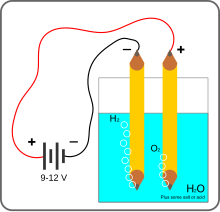NortH2
NortH2 is the name for the consortium of the Dutch companies Shell, Gasunie and Groningen Seaports with the aim of producing around 800,000 tons of “green” hydrogen annually by 2040 .
Near the German border, in Eemshaven , the construction of what will then be the largest hydrogen plant for green hydrogen in Europe with many electrolysers is to take place. In 2027 the first plants are to produce “green” hydrogen from offshore wind power. The offshore wind park required for this is in the planning stage. The wind farm with a planned installed capacity of 10 GW is expected to cost around four billion euros. It should supply the electricity and the electrolysis process should convert the wind power to hydrogen (Power-To-X) for long-term storage.
The energetic efficiency of the electrolysis of water is over 70% Several system manufacturers (e.g. Electrolyser Corp., Brown Boveri, Lurgi, De Nora, Epoch Energy Technology Corp.) offer large electrolysis devices with an even higher efficiency (over 80%) on. MIT scientists have developed a catalyst that is said to increase the efficiency of the electrolysis of water to almost 100%.
NortH2 is not the only project in this technology. Together with the transmission network operator Tennet and the long- distance network operator Thyssengas , Gasunie wants to build several large electrolysis plants with a total of 100 megawatts in a large Power-To-X project in Diele, Lower Saxony. In Diele, the electricity already arrives via cables from the North Sea as direct current and does not burden the domestic high-voltage three-phase network and is therefore probably not burdened with the high EEG surcharges of currently around 6 ct / kWh (higher than the generation costs). Because green hydrogen has a hard time as long as natural gas is available and polluted with comparatively low CO 2 emissions. The offshore wind current in Germany, on the other hand, is burdened with high tax surcharges, levies and levies and is thus slowing down the German energy transition.
Therefore, another project by Tennet is particularly interesting, which wants to build an artificial island in the North Sea with a consortium of companies from the energy industry in order to install an offshore energy distribution network with hydrogen production. This island outside of national jurisdiction is largely exempt from the extremely high national duties and taxes as in Germany.
Individual evidence
- ↑ S. Milanzi, C. Spiller, B. Grosse, L. Hermann, J. Kochems, J. Müller-Kirchenbauer: Technical status and flexibility of the power-to-gas process. (PDF; 1.16 MB) Technische Universität Berlin , August 29, 2018, accessed on March 1, 2020 .
- ↑ MIT claims 24/7 solar power , dated July 31, 2008, accessed on February 2, 2020
- ↑ Record: billion growth on the EEG account. iwr.de, March 10, 2017, accessed on March 1, 2020 .
Web links
- Construction of the largest green hydrogen plant accessed on February 28, 2020
- https://northseawindpowerhub.eu/wp-content/uploads/2019/11/NSWPH-Drieluik-Herdruk_v01.pdf , accessed on February 29, 2020
